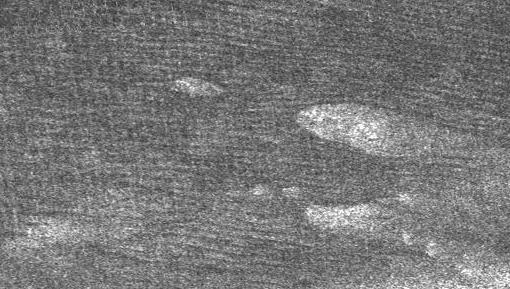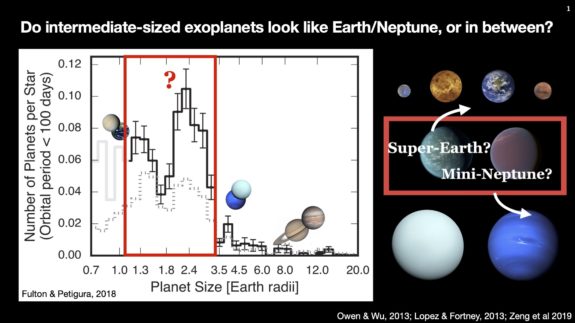On Wednesday, Staff Writer Charlie Bonkowsky attended “Planets In A Bottle—From Titan To Exoplanets,” a colloquium presented by Xinting Yu, a postdoc fellow at the University of California Santa Cruz.
What’s your favorite planet or moon in the solar system?
If you answered Titan, you’re in good company. The hazy moon of Saturn is also Xinting Yu’s favorite, and what she did her first research on as a graduate student at the NASA Ames Research Center. In her colloquium, she spoke about how her work in sand transport and dune formation led to her current research into the atmospheres of exoplanets—and the difficulties of studying sand and clouds across trillions of miles, where entire planets and stars are no more than specks in a telescope’s lens.
The first thing you can do to close that gap, she said, is look back on Earth when you spot something you don’t understand. When the Cassini-Huygens mission imaged the surface of Titan, it spotted long, dark ridges stretching on the surface, nicknamed ‘cat scratches’—which bear a striking resemblance to linear sand dunes here on Earth.

Yu began her work at the Titan Wind Tunnel at Ames, a million-dollar facility designed to understand how dunes are created on Titan, where the atmospheric conditions are wildly different than here on Earth. But on the first day there, she was shocked to find out that the materials in this expensive, finely-calibrated were…ground-up walnut shells and instant coffee. Not quite the perfect equivalent to the sands of Titan. (In fact, they’d originally been used to test conditions on Mars, their low density mimicking the lower gravity there, and never swapped out.)
What are the sands on Titan made of? The thick orange haze which blankets the planet is formed when energetic particles from Saturn’s magnetosphere or UV light from the sun breaks apart methane and ammonia particles in its atmosphere. These compounds which compose the haze, Yu said, are likely also depositing organic particles onto Titan’s surface which forms the sand—and which must have a better analog than walnut shells!
Replicating the process of haze formation and deposition in the laboratory creates tholins, the same compounds which blanket Titan’s surface. Just not enough of them at once: it took several days of work to create 300 milligrams of tholins, Yu said, and work in the wind tunnel requires kilograms of material. Finding something they could reasonably use in the Titan Wind Tunnel, then, became Yu’s PhD journey: to figure out what material properties of tholins matter for sand transport, and mimic only those.
As it turns out:
- Titan sand is stickier than Earth sand, meaning a higher-than-expected wind speed is needed to move sand and form dunes on Titan
- Titan sand doesn’t carry any static charge, so dune formation doesn’t rely on particle charging
- Titan sand is less sturdy than Earth sand, so it can’t travel as far without being ground into dust
NASA is also very interested in Titan-sand simulants, because they’re planning to go back. The Dragonfly mission—which Yu deemed “the coolest mission ever”—is proposed for 2034, to fly around on Titan and study its surface material. So to test the spacecraft, NASA needs a Titan material, made in bulk, like those made for Moon missions, Mars missions, and even asteroid missions. Creating a polymer with all the properties of Titan’s sand, in bulk, is one of Yu’s current projects, both for the Dragonfly probe and, of course, the Titan Wind Tunnel.
But the exciting thing about planetary research like this, she said, is that it’s also applicable to exoplanet research. The field is still in its infancy—we only started discovering exoplanets 30 years ago—but has already developed its own share of thorny problems. First, scientists have discovered many planets with sizes between Earth and Neptune, but don’t really know what their composition is: are they massive rocky planets with a surface, or small gas giants without one? And second, when telescopes try to peer directly at exoplanets’ surfaces, they’re often blocked by haze.

So, Yu said, let’s return to the first rule of planetary scientists: look back at Earth (or in this case, the Solar System) to understand the interactions going on here. If we compare the atmospheres of Jupiter, a gas giant with no surface, and Titan, a moon with a shallow surface, we should see if certain chemicals in their atmosphere behave differently. And they do! Ammonia and methane are broken apart by energetic particles in both bodies’ atmospheres. On Jupiter, these broken-up chemicals sink down into lower regions of its atmosphere, where heat and pressure recombine them. On Titan, lacking that lower layer of atmosphere, ammonia and methane can’t recombine. Thus, a lack of ammonia and methane in an exoplanet’s atmosphere is likely indicative of a thin atmosphere and shallow surface, while an abundance of those chemicals indicative of a deeper atmosphere.

Exoplanet atmospheres are much easier to see than exoplanet surfaces—if not for the haze. And this isn’t the same type of haze we see in the Solar System, Yu said: many of the exoplanets we observe are very close to their parent star, and have more exotic hazes: silicate, titanium oxides, or mineral-rich clouds. But here, she said, the same techniques as studying sand transport on Titan apply. The same material properties apply for cloud formation, along with thermal properties and, because they’re astronomers, optical properties.
Forming clouds is a tricky process. Most condensable materials find a seed of foreign material to “grow on” or condense around, and, depending on their properties, it can be easier or harder for different material to form clouds. What she found in her research was that around a temperature of 400 Kelvin, condensates had the lowest surface energy, and were most likely to form hazes. Matching that up to actual exoplanet data confirmed their findings: planets in the mid-temperature range, of 300-500 K, tended to have the most haze in their atmosphere.
Most astronomers, she said, would still like to see through the haze. But at least this can allay their worst fears—even if the fancy new James Webb Space Telescope only sees hazy planets (hopefully not!), atmospheric physics and chemistry can still tell us what we’re looking at.
Titan Obscured By Rings via NASA/JPL-Caltech/SSI
Cat-Scratch Dunes via NASA/JPL-Caltch/ASI
Intermediate-Size Exoplanets and Atmospheric Cycles via Xinting Yu


 0 Comments
0 Comments